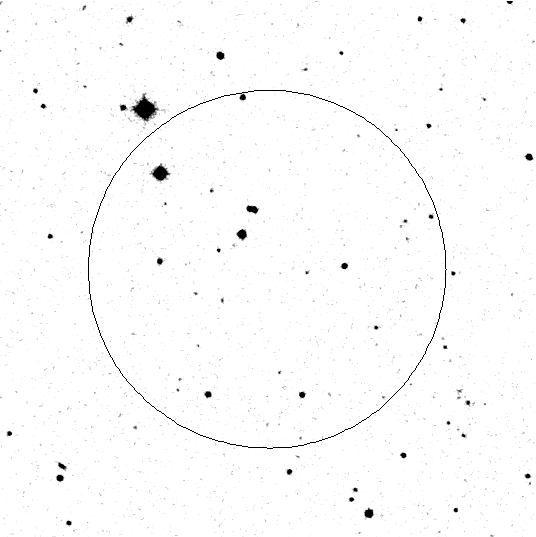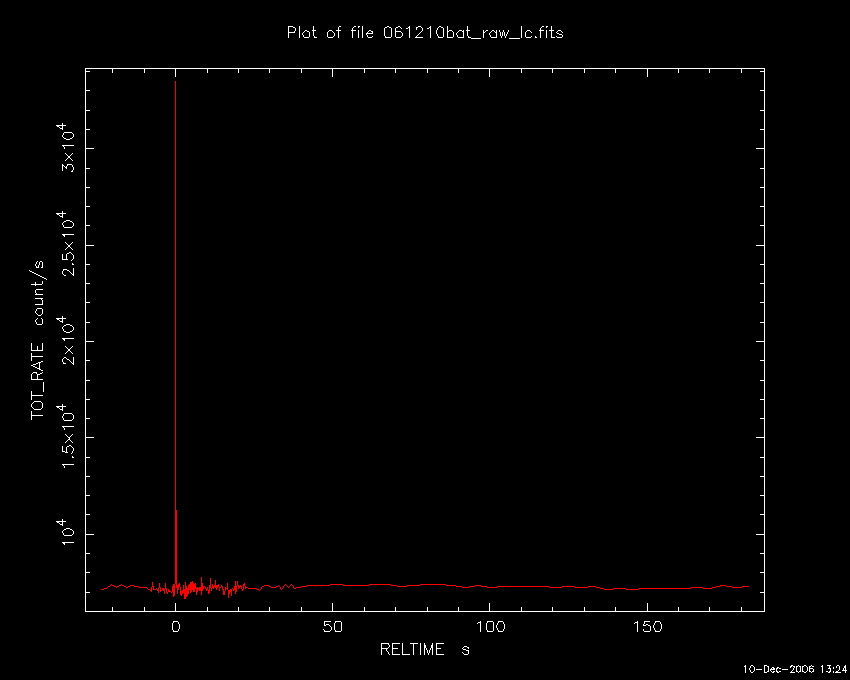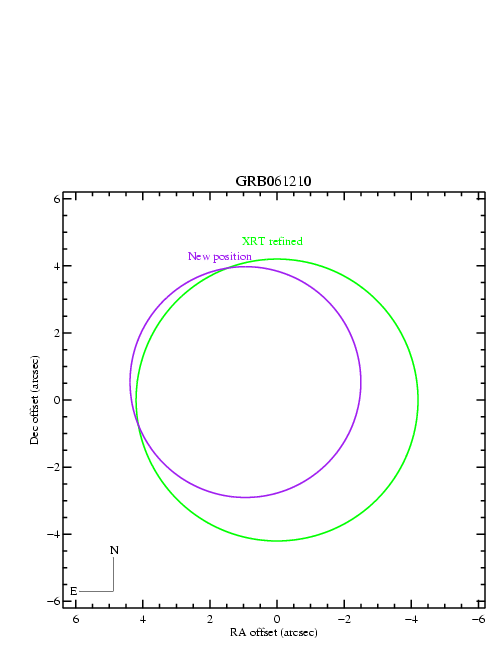- GCN/BACODINE POSITION NOTICE
TITLE: GCN/SWIFT NOTICE
NOTICE_DATE: Sun 10 Dec 06 12:20:54 UT
NOTICE_TYPE: Swift-BAT GRB Position
TRIGGER_NUM: 243690, Seg_Num: 0
GRB_RA: 144.514d {+09h 38m 03s} (J2000),
144.609d {+09h 38m 26s} (current),
143.827d {+09h 35m 19s} (1950)
GRB_DEC: +15.632d {+15d 37' 56"} (J2000),
+15.601d {+15d 36' 02"} (current),
+15.858d {+15d 51' 28"} (1950)
GRB_ERROR: 3.00 [arcmin radius, statistical only]
GRB_INTEN: 2354 [cnts] Image_Peak=190 [image_cnts]
TRIGGER_DUR: 0.032 [sec]
TRIGGER_INDEX: 10327 E_range: 50-350 keV
BKG_INTEN: 24022 [cnts]
BKG_TIME: 44430.37 SOD {12:20:30.37} UT
BKG_DUR: 8 [sec]
GRB_DATE: 14079 TJD; 344 DOY; 06/12/10
GRB_TIME: 44439.33 SOD {12:20:39.33} UT
GRB_PHI: 140.36 [deg]
GRB_THETA: 37.59 [deg]
SOLN_STATUS: 0x3
RATE_SIGNIF: 211.50 [sigma]
IMAGE_SIGNIF: 12.35 [sigma]
MERIT_PARAMS: +1 +0 +0 -5 +3 +30 -5 +0 +44 +1
SUN_POSTN: 257.28d {+17h 09m 07s} -22.92d {-22d 55' 21"}
SUN_DIST: 116.53 [deg] Sun_angle= 7.5 [hr] (West of Sun)
MOON_POSTN: 148.41d {+09h 53m 39s} +15.08d {+15d 05' 04"}
MOON_DIST: 3.70 [deg]
MOON_ILLUM: 70 [%]
GAL_COORDS: 217.07, 43.83 [deg] galactic lon,lat of the burst (or transient)
ECL_COORDS: 141.66, 1.42 [deg] ecliptic lon,lat of the burst (or transient)
COMMENTS: SWIFT-BAT GRB Coordinates.
COMMENTS: This is a rate trigger.
COMMENTS: A point_source was found.
COMMENTS: This does not match any source in the on-board catalog.
COMMENTS: This does not match any source in the ground catalog.
COMMENTS: This is a GRB.
COMMENTS: This trigger occurred at longitude,latitude = 181.45,15.82 [deg].
- red DSS finding chart
ps-file

- GCN NOTICE
TITLE: GCN/SWIFT NOTICE
NOTICE_DATE: Sun 10 Dec 06 12:24:24 UT
NOTICE_TYPE: Swift-BAT GRB Lightcurve
TRIGGER_NUM: 243690, Seg_Num: 0
GRB_RA: 144.514d {+09h 38m 03s} (J2000),
144.609d {+09h 38m 26s} (current),
143.827d {+09h 35m 19s} (1950)
GRB_DEC: +15.632d {+15d 37' 56"} (J2000),
+15.601d {+15d 36' 02"} (current),
+15.858d {+15d 51' 28"} (1950)
GRB_DATE: 14079 TJD; 344 DOY; 06/12/10
GRB_TIME: 44439.55 SOD {12:20:39.55} UT
TRIGGER_INDEX: 10327
GRB_PHI: 140.36 [deg]
GRB_THETA: 37.59 [deg]
DELTA_TIME: 42.00 [sec]
TRIGGER_DUR: 0.032 [sec]
SOLN_STATUS: 0x3
RATE_SIGNIF: 211.50 [sigma]
IMAGE_SIGNIF: 12.35 [sigma]
LC_URL: sw00243690000msb.lc
SUN_POSTN: 257.28d {+17h 09m 08s} -22.92d {-22d 55' 22"}
SUN_DIST: 116.53 [deg] Sun_angle= 7.5 [hr] (West of Sun)
MOON_POSTN: 148.44d {+09h 53m 46s} +15.07d {+15d 04' 19"}
MOON_DIST: 3.73 [deg]
MOON_ILLUM: 70 [%]
GAL_COORDS: 217.07, 43.83 [deg] galactic lon,lat of the burst (or transient)
ECL_COORDS: 141.66, 1.42 [deg] ecliptic lon,lat of the burst (or transient)
COMMENTS: SWIFT-BAT GRB Lightcurve.
COMMENTS:
COMMENTS: The next comments were copied from the BAT_POS Notice:
COMMENTS: This is a rate trigger.
COMMENTS: A point_source was found.
COMMENTS: This does not match any source in the on-board catalog.
COMMENTS: This does not match any source in the ground catalog.
COMMENTS: This is a GRB.
COMMENTS: This trigger occurred at longitude,latitude = 181.45,15.82 [deg].

- GCN Circular #5904
J, K. C. Cannizzo (NASA/UMBC), L. M. Barbier (NASA/GSFC),
S. D. Barthelmy (GSFC), N. Gehrels (NASA/GSFC),
C. B. Markwardt (GSFC/UMD), J. P. Osborne (U Leicester),
K. L. Page (U Leicester), D. M. Palmer (LANL) and
M. Stamatikos (NASA/ORAU) report on behalf of the Swift Team:
At 12:20:39 UT, the Swift Burst Alert Telescope (BAT) triggered and
located GRB 061210 (trigger=243690). Swift did not slew because
of the Moon observing constraint -- this burst is 4 deg from the Moon.
The BAT on-board calculated location is
RA, Dec 144.514, +15.632 which is
RA(J2000) = 09h 38m 03s
Dec(J2000) = +15d 37' 56"
with an uncertainty of 3 arcmin (radius, 90% containment, including
systematic uncertainty). The BAT light curve shows a single spike
structure with a duration of about 0.8 sec. The peak count rate
was ~27,000 counts/sec (15-350 keV), at ~0 sec after the trigger.
No XRT or UVOT observations will be possible until the burst
emerges from the spacecraft Moon constraint in about 1.5 days.
- GCN Circular #5905
D. Palmer (LANL), L. Barbier (GSFC), S. D. Barthelmy (GSFC),
J. K. Cannizzo (GSFC/UMBC), J. Cummings (GSFC/UMBC), E. Fenimore (LANL),
N. Gehrels (GSFC), D. Hullinger (BYU-Idaho), H. Krimm (GSFC/USRA),
C. Markwardt (GSFC/UMD), A. Parsons (GSFC), T. Sakamoto (GSFC/ORAU),
G. Sato (GSFC/ISAS), M. Stamatikos (GSFC/ORAU), J. Tueller (GSFC)
on behalf of the Swift-BAT team:
Using the data set from T-239 to T+478 sec from the recent telemetry downlink,
we report further analysis of BAT GRB 061210 (trigger #243690)
(Cannizzo, et al., GCN Circ. 5904). The BAT ground-calculated position
is RA, Dec = 144.521, 15.613 deg which is
RA(J2000) = 09h 38m 05.1s
Dec(J2000) = 15d 36' 46.3"
with an uncertainty of 2.3 arcmin, (radius, sys+stat, 90% containment).
The partial coding was 30%.
The mask-weighted lightcurve has a hard FRED-like spike lasting a total
of ~192 msec followed by much weaker, softer emssion lasting out to ~T+90 sec.
T90 (15-350 keV) is 85 +- 5 sec (estimated error including systematics).
The event-by-event data shows the FRED-like peak is resolved to 3 somewhat
overlapping spikes within 60 msec.
The time-averaged spectrum from T+0.2 to T+89.6 is best fit by a simple
power-law model. The power law index of the time-averaged spectrum is
1.55 +- 0.28. The fluence in the 15-150 keV band is 1.1 +- 0.2 x 10^-6
erg/cm2. The 1-sec peak photon flux measured from T-0.01 sec in the
15-150 keV band is 5.3 +- 0.5 ph/cm2/sec.
The spectrum of the first spike alone (T+0.212 to T+0.760 sec) is also
fit by a simple power law model. The power law index of the initial
spike is 0.79 +- 0.15. The fluence in the 15-150 keV band is
3.0 +- 0.3 x 10^-7 erg/cm2.
All the quoted errors are at the 90% confidence level.
- GCN Circular #5906
N. Mirabal & J. P. Halpern (Columbia U.) report on behalf of the
MDM Observatory GRB follow-up team:
"We observed the entire Swift BAT error circle of short GRB 061210
(Cannizzo et al., GCN 5904; Palmer et al., GCN 5905) in the I band
on the MDM 1.3m telescope. Combined exposures obtained in the
interval 39-66 minutes after the burst show no new object to a
limiting magnitude of I~18.5 in comparison with the USNO-B1.0
catalog, despite high background from the nearby bright moon.
This message may be cited."
- GCN Report 20.1
GCN_Report 20.1 has been posted:
http://gcn.gsfc.nasa.gov/reports/report_20_1.pdf
by J.K. Cannizzo
at NASA/UMBC
titled: "Swift Observations of GRB 061210"
- GCN Circular #5910
Poonam Chandra (NRAO/UVA) and Dale A. Frail (NRAO) report on behalf of
the Caltech-NRAO-Carnegie GRB Collaboration:
"We used the Very Large Array to observe the field of view toward GRB
061210 (GCN 5904) at a frequency of 8.46 GHz on 2006 December 12 at
9.81 UT. The peak radio brightness at the BAT ground-calculated position
(GCN 5905) is 26 uJy +- 34 uJy. The nearest source in the GRB field of
view
is at a distance of 3.54 arcmin, cataloged in NVSS and FIRST survey as
J093751+153629.
The National Radio Astronomy Observatory is a facility of the National
Science Foundation operated under cooperative agreement by Associated
Universities, Inc."
- GCN Circular #5912
S. B. Cenko (Caltech), D. B. Fox (Penn State), and P. A. Price
(IfA/Hawaii) report on behalf of a larger collaboration:
We observed the field of the short-hard GRB061210 (Cannizzo et al., GCN
5904) with the Gemini Multi-Object Spectrograph in imaging mode mounted
on the Gemini North telescope. Our first set of observations was taken
in r' at a mean epoch of 14:27 Dec. 10 UT (2.1 hours after the burst)
and covers ~ 90% of the refined BAT error circle (Palmer et al., GCN
5905). Contamination from the nearby moon significantly affected the
sensitivity of these images.
A second r' reference epoch was taken the following evening, at a mean
epoch of 13:54 Dec. 11 UT (25.6 hours after the burst). Digital image
subtraction using the ISIS software package (Alard & Lupton 1998, ApJ,
v. 503, p. 325) revealed no variable object anywhere in the field. We
place a limit of r' > 23.5 mag for any isolated point-source afterglow
emission at the time of the first epoch.
- GCN Circular #5917
Y. Urata, M. Tashiro, K. Abe, K. Onda, Y. Sato, M. Suzuki, (Saitama U.),
K. Yamaoka, S. Sugita (Aoyama Gakuin U.), M. Ohno, T. Takahashi,
T. Asano, T. Uehara, Y. Fukazawa (Hiroshima U.), T. Enoto, K. Kokubun,
K. Makishima, R. Miyawaki (Univ. of Tokyo), M. Suzuki, T. Tamagawa,
Y. Terada (RIKEN), K. Nakazawa, T. Takahashi (ISAS/JAXA), S. Hong (Nihon U.),
on behalf of the Suzaku WAM team report:
"The short GRB 061210 (Cannizzo et al. GCN 5904, Palmer et al GCN
5905) triggered the Suzaku Wideband All-sky Monitor (WAM), which
covers the energy range of 50 keV - 5 MeV, at 12:20:39 UT December 10,
2006. The duration T90 was about 0.047 second. The fluence in 100 -
1000 keV of the burst was about 2.02 (-0.33, +0.35) x 10-6
erg/cm2. Preliminary result shows that the time-averaged spectrum is
well described by a single power-law model with the photon index
1.55(-0.19,+0.22). All the quoted errors are at statistical 90%
confidence level, while systematic errors are not included.
The WAM light curve of this event is available at
http://www.astro.isas.jaxa.jp/suzaku/HXD-WAM/WAM-GRB/grb/grb_table.html
- GCN Circular #5920
A. Melandri, D. Carter , C. Mundell, A. Gomboc, C. Guidorzi,
I.A. Steele, C.J. Mottram, D.F. Bersier, S. Kobayashi, R.J. Smith,
M.F. Bode (Liverpool JMU), P. O'Brien, E. Rol, N. Bannister
(Leicester) report:
"The 2-m Faulkes North Telescope robotically followed up the Swift
GRB061210 (trigger #243690, Cannizzo et al) and began observing
about 2.4 minutes after the GRB trigger time.
Observations were affected by the nearby bright moon (~4.3 degrees)
and no new object was found inside the BAT error circle (Palmer et
al., GCN 5905).
From the acquired set of 3x10 seconds exposures in the R-band we
can set an upper limit for the afterglow of R>17.0 at 2.8 minutes
(mean time).
This message may be cited."
- GCN Circular #5921
O. Godet, K. Page, P. Evans, A. P. Beardmore (U. Leicester), D. N.
Burrows (PSU), J. K. Cannizzo (LANL) report on behalf of the Swift XRT
team:
We analysed 26ks of XRT data for the short burst GRB 061210 (Cannizzo et
al., GCN Circ. 5904) taken between 2.42 days and 2.72 days after the BAT
trigger. Swift observed this burst late due to a Moon constraint. The
XRT/PC image shows two sources S1 and S2 in the BAT error circle located
at:
S1: RA(J2000)=09h 37m 57.55s
Dec(J2000)=+15d 36' 30.8"
with an uncertainty of 4.1" (90% containment). The source S1 is 110"
from the BAT position quoted in Palmer et al. (GCN Circ. 5905).
S2: RA(J2000)=09h 38m 05.17s
Dec(J2000)=+15d 37' 16.0"
with an uncertainty of 4.2" (90% containment). The source S2 is 30" from
the BAT position quoted in Palmer et al. (GCN Circ. 5905).
The two sources are uncatalogued. We note that a slightly elliptical
object located at 12.1" from the position of the source S2 is seen in
the DSS images. This corresponds to the source EO1509-0232011 in the
APM-North catalogue. It has a r-magnitude of 17.24 and a b-magnitude of
22.12.
With the data so far available we can not tell if either S1 or S2 are
fading. However, the XRT will continue to observe the field.
This circular is an official product of the Swift XRT Team.
- GCN Circular #5922
E. Berger (Carnegie Observatories) reports on behalf of a larger
collaboration:
"Inspection of our Gemini/GMOS images (GCN #5912) at the positions of XRT
sources S1 and S2 (GCN #5921) reveal the presence of several extended
optical sources, one of which may be the host galaxy of GRB 061210.
Within the error circle of source S1 we detect a single extended object
with r=24.8+/-0.2 mag (S1-G1).
Similarly, within the error circle of source S2 we detect an extended
object with r=24.8+/-0.2 mag (S2-G1), as well as a brighter galaxy with a
bulge-dominated morphology on the edge of the error circle with
r=21.0+/-0.02 mag (S2-G2), and a third galaxy about 1.5" outside of the
error circle with r=22.9+/-0.05 mag (S2-G3). All magnitudes are derived
using the zeropoint available on the GMOS website.
We note that the elliptical object EO1509-0232011 mentioned in GCN 5921 is
not visible in our images (or in DSS2) and it is likely to be a high
proper motion star.
In the absence of X-ray or optical variability it is unclear which (if
any) of these galaxies is the host of GRB 061210. However, if source S2
is shown to be the X-ray afterglow, the most likely host galaxy is S2-G2
given its brightness and consistent location with the XRT error circle."
- GCN Circular #5924
Cucchiara A. (PSU), Cannizzo J. (NASA/UMBC) reports on
behalf of the Swift/UVOT team:
The Swift/UVOT observed the field of GRB061210 starting
2.42 days after the BAT trigger (Cannizzo et al.,
GCN Circ. 5904).
No afterglow optical candidate is detected in either of the
XRT error circles in 18.5 ks of exposure time from T+2.42 days
to T+3.48 days in U band.
We clearly detect the extended source near the candidate S1
(Berger et al., GCN Circ. 5922) at the following coordinates:
RA(J2000) = 09:37:57.92
DEC(J2000) = +15:36:32.6
with a 1 sigma error radius of about 0.5 arcsec.
The estimated UVOT/U magnitude is 21.0 +/- 0.1.
In a second epoch image taken from T+3.5 days to T+3.64 after
the trigger the source is still present and it is not fading.
The estimated magnitude in 12 ks coadded image is 21.0 +/- 0.1.
In the position of the candidate S2 we estimate a 3 sigma upper
limit of 22.06.
The values quoted above are not corrected for the expected Galactic
extinction of E_{B-V} = 0.035 mag (Schlegel et al. 1998).
- GCN Circular #5925
N. Mirabal, J. P. Halpern, & J. Corby (Columbia U.) report on behalf
of the MDM Observatory GRB follow-up team:
"Following our initial observation of the entire Swift BAT error circle
(GCN 5906), we continued observing the XRT candidates of short GRB 061210
(Godet et al., GCN 5921) using V, R and I filters on the MDM 1.3m
telescope on Dec. 12-13 UT. In a summed 60-minute exposure centered
at Dec. 13 09:03 UT, we clearly detect the extended galaxy
candidate "S2-G2" reported by Berger (GCN 5922) at coordinates
RA(J2000) = 09:38:05.3, Dec(J2000) = 15:37:18.9 (+/- 0.5''). Preliminary
photometry yields R ~ 20.9 +/- 0.2 in comparison with the USNO-B1.0
catalog, which is consistent with the value reported by Berger. As an
aside, we
note the relative high concentration of optical galaxies toward
RA(J2000) = 09:37:52.5, Dec(J2000) = 15:36:24.9 that should be tested as
a possible galaxy cluster host of this short GRB.
This message may be cited."
- GCN Circular #5946
S. B. Cenko, M. Kasliwal, P. B. Cameron, S. R. Kulkarni (Caltech) and D.
B. Fox (Penn State) report on behalf of a larger collaboration:
We have obtained a spectrum of the possible host galaxy S2-G2 (Berger, GCN
5922) of the short-hard GRB061210 (Cannizzo et al., GCN 5904). S2-G2 is
an r=21 galaxy with a bulge-dominated morphology on the outskirts of the
possible XRT afterglow S2 (Godet et al., GCN 5921). Using the
Low-Resolution Imaging Spectrometer mounted on the 10-m Keck I telescope,
we obtained 2 x 30 min spectra of this galaxy at a mean epoch of ~ 13:30
Dec 19 UT. We measure a redshift of z = 0.41 based on emission lines of
[OII], [OIII], and HI. With a 15-150 keV fluence of 1.1e-6 erg/cm^2
(Palmer et al., GCN 5905), this corresponds to an isotropic prompt energy
release of 4.6e50 ergs.
- GCN Circular #5983
J. L. Racusin (PSU), O. Godet, (U. Leicester), J. K. Cannizzo (NASA/UMBC),
D. Fox (PSU), and N. Gehrels (NASA/GSFC) report on behalf of the Swift XRT
team:
We have re-analyzed the full XRT data set of GRB 061210. XRT observed the
field of GRB 061210 for a total exposure time of 73 ks between December 12
and December 20, 2006 in Photon Counting mode.
Godet et al. (GCN 5921) identified 2 potential X-ray afterglow candidates
(S1 & S2). After further observations to characterize fading behavior, we
have concluded that S2 is the X-ray afterglow.
To further improve the accuracy of the position previously quoted, we
performed an astrometric correction using 66 ks of the total exposure time
(when the satellite position was stable). In this data set we find 22
serendipitous X-ray sources detected with the XIMAGE detect algorithm with
S/N > 3, 6 of which have near-by optical counterparts in the USNO-B1
catalog. We match these sources to obtain a best fit mean frame shift,
carefully accounting for several instrumental factors including exposure
map correction, and additional hot pixel removal.
We calculate the statistical position errors using the empirical fits as
described in Moretti et al. (2006, A&A, 448, L9), assuming that the
astrometric correction removes the 3.5" systematic error normally applied
to XRT positions to account for errors in the star tracker attitude
solution.
The result of this analysis leads to a mean frame shift from the
previously reported position (Godet et al., GCN 5921) Source 2, of:
RA offset: +0.036s +/- 0.055s Dec offset: +0.13 +/- 0.8"
and a new XRT astrometry corrected position of:
RA(J2000): 09 38 05.24
Dec(J2000): +15 37 16.5
with an estimated uncertainty of 3.4 arcseconds (radius, 90% containment).
This position is 1.1 arcseconds from the original refined XRT position of
S2 given in Godet et al. (GCN 5921), and 2.6 arcseconds from the potential
S2-G2 host galaxy described by Berger et al. (GCN 5922) and Mirabal et al.
(GCN 5925) with z=0.41 (Cenko et al., GCN 5946).
A figure comparing all of these positions is available at:
http://www.swift.psu.edu/images/grb061210_astrometry.gif
This circular is an official product of the Swift XRT team.

- More accurate redshift z=0.4095 (from host galaxy)
Berger et al., arXiv:astro-ph/0611128
![]() Previous IAU Circulars
Previous IAU Circulars 

